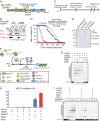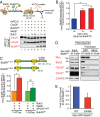Bimodal activation of BubR1 by Bub3 sustains mitotic checkpoint signaling
- PMID: 25246557
- PMCID: PMC4210015
- DOI: 10.1073/pnas.1416277111
Bimodal activation of BubR1 by Bub3 sustains mitotic checkpoint signaling
Abstract
The mitotic checkpoint (also known as the spindle assembly checkpoint) prevents premature anaphase onset through generation of an inhibitor of the E3 ubiquitin ligase APC/C, whose ubiquitination of cyclin B and securin targets them for degradation. Combining in vitro reconstitution and cell-based assays, we now identify dual mechanisms through which Bub3 promotes mitotic checkpoint signaling. Bub3 enhances signaling at unattached kinetochores not only by facilitating binding of BubR1 but also by enhancing Cdc20 recruitment to kinetochores mediated by BubR1's internal Cdc20 binding site. Downstream of kinetochore-produced complexes, Bub3 promotes binding of BubR1's conserved, amino terminal Cdc20 binding domain to a site in Cdc20 that becomes exposed by initial Mad2 binding. This latter Bub3-stimulated event generates the final mitotic checkpoint complex of Bub3-BubR1-Cdc20 that selectively inhibits ubiquitination of securin and cyclin B by APC/C(Cdc20). Thus, Bub3 promotes two distinct BubR1-Cdc20 interactions, involving each of the two Cdc20 binding sites of BubR1 and acting at unattached kinetochores or cytoplasmically, respectively, to facilitate production of the mitotic checkpoint inhibitor.
Conflict of interest statement
The authors declare no conflict of interest.
Figures






Similar articles
-
Unattached kinetochores catalyze production of an anaphase inhibitor that requires a Mad2 template to prime Cdc20 for BubR1 binding.Dev Cell. 2009 Jan;16(1):105-17. doi: 10.1016/j.devcel.2008.11.005. Dev Cell. 2009. PMID: 19154722 Free PMC article.
-
Catalytic assembly of the mitotic checkpoint inhibitor BubR1-Cdc20 by a Mad2-induced functional switch in Cdc20.Mol Cell. 2013 Jul 11;51(1):92-104. doi: 10.1016/j.molcel.2013.05.019. Epub 2013 Jun 20. Mol Cell. 2013. PMID: 23791783 Free PMC article.
-
BubR1 blocks substrate recruitment to the APC/C in a KEN-box-dependent manner.J Cell Sci. 2011 Dec 15;124(Pt 24):4332-45. doi: 10.1242/jcs.094763. Epub 2011 Dec 22. J Cell Sci. 2011. PMID: 22193957 Free PMC article.
-
The mitotic checkpoint: a signaling pathway that allows a single unattached kinetochore to inhibit mitotic exit.Prog Cell Cycle Res. 2003;5:431-9. Prog Cell Cycle Res. 2003. PMID: 14593737 Review.
-
Dual inhibition of Cdc20 by the spindle checkpoint.J Biomed Sci. 2007 Jul;14(4):475-9. doi: 10.1007/s11373-007-9157-3. Epub 2007 Mar 17. J Biomed Sci. 2007. PMID: 17370142 Review.
Cited by
-
Arrest of Cell Cycle by Avian Reovirus p17 through Its Interaction with Bub3.Viruses. 2022 Oct 28;14(11):2385. doi: 10.3390/v14112385. Viruses. 2022. PMID: 36366482 Free PMC article.
-
Two functionally distinct kinetochore pools of BubR1 ensure accurate chromosome segregation.Nat Commun. 2016 Jul 26;7:12256. doi: 10.1038/ncomms12256. Nat Commun. 2016. PMID: 27457023 Free PMC article.
-
The Arabidopsis BUB1/MAD3 family protein BMF3 requires BUB3.3 to recruit CDC20 to kinetochores in spindle assembly checkpoint signaling.Proc Natl Acad Sci U S A. 2024 Mar 19;121(12):e2322677121. doi: 10.1073/pnas.2322677121. Epub 2024 Mar 11. Proc Natl Acad Sci U S A. 2024. PMID: 38466841 Free PMC article.
-
Integrating Vascular Phenotypic and Proteomic Analysis in an Open Microfluidic Platform.ACS Nano. 2024 Sep 10;18(36):24909-24928. doi: 10.1021/acsnano.4c05537. Epub 2024 Aug 29. ACS Nano. 2024. PMID: 39208278 Free PMC article.
-
Oral lichen planus and malignant transformation: The role of p16, Ki-67, Bub-3 and SOX4 in assessing precancerous potential.Exp Ther Med. 2018 May;15(5):4157-4166. doi: 10.3892/etm.2018.5971. Epub 2018 Mar 20. Exp Ther Med. 2018. PMID: 29731815 Free PMC article.
References
-
- Skibbens RV, Rieder CL, Salmon ED. Kinetochore motility after severing between sister centromeres using laser microsurgery: Evidence that kinetochore directional instability and position is regulated by tension. J Cell Sci. 1995;108(Pt 7):2537–2548. - PubMed
-
- Lara-Gonzalez P, Westhorpe FG, Taylor SS. The spindle assembly checkpoint. Curr Biol. 2012;22(22):R966–R980. - PubMed
-
- Jia L, Kim S, Yu H. Tracking spindle checkpoint signals from kinetochores to APC/C. Trends Biochem Sci. 2013;38(6):302–311. - PubMed
-
- Shah JV, et al. Dynamics of centromere and kinetochore proteins; implications for checkpoint signaling and silencing. Curr Biol. 2004;14(11):942–952. - PubMed
Publication types
MeSH terms
Substances
Grants and funding
LinkOut - more resources
Full Text Sources
Other Literature Sources
Miscellaneous

